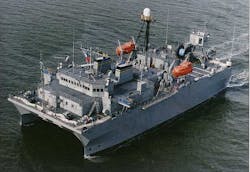Lockheed Martin to build towed-array sonar systems for Navy undersea surveillance of submarines
Officials of the Space and Naval Warfare Systems Command (SPAWAR) in San Diego, announced a $30 million order late last month to the Lockheed Martin Rotary and Mission Systems segment in Liverpool, N.Y., for two U.S. twin line towed array (TL-29A) systems.
These twin-line towed-array sonar systems are to support the Naval Sea Systems Command's Maritime Surveillance Systems Program Office, Program Executive Office Submarines.
The twin-line 29A array (TL-29A) is a passive, low-frequency sensor towed by the T-AGOS surveillance ship. Each array comprises a chain of acoustic, telemetry, and interface modules linked together in an integrated system.
The TL-29A's passive acoustic and signal-processing technologies can hear submarines at long range and in various sea states. The towed-array sonar is designed particularly to detect and track the new generation of extremely quiet diesel electric submarines operated by foreign navies.
Related: L-3 to build six more TB-29A CTA towed array sonar systems for Virginia-class submarines
The TL-29A sonar is configured as a pair of mile-long arrays that are towed side-by-side from an electro-optic tow cable attached to a winch on the deck of the host surface ship.
Two critical advantages of the TL-29A in the current threat environment are its endurance and ability to be towed in the shallow waters of the littoral zones in coastal waters and in harbors.
As a passive sensor, TL-29A does not generate a signal but uses sensitive hydrophones to listen for the faint sounds emitted by extremely quiet diesel electric submarines.
The TL-29A, along with its submarine-mounted cousin, the TB-29A, is the first array to use an advanced telemetry called towed array integrated product team (TAIPT). The TAIPT is a commercial off-the-shelf (COTS)-based telemetry architecture.
On this contract Lockheed Martin will do the work in Syracuse, N.Y., and should be finished by October 2019. For more information contact Lockheed Martin Rotary and Mission Systems online at www.lockheedmartin.com/us/rms.html, or SPAWAR at www.spawar.navy.mil.
Learn more: search the Aerospace & Defense Buyer's Guide for companies, new products, press releases, and videos
